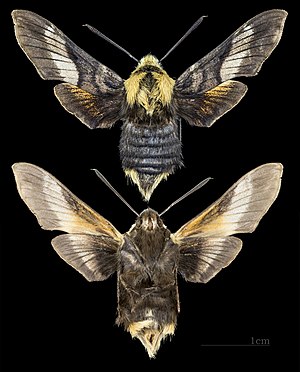Proserpinus flavofasciata
| Proserpinus flavofasciata | ||||||||||||
|---|---|---|---|---|---|---|---|---|---|---|---|---|

Proserpinus flavofasciata |
||||||||||||
| Systematics | ||||||||||||
|
||||||||||||
| Scientific name | ||||||||||||
| Proserpinus flavofasciata | ||||||||||||
| ( Walker , 1856) |
Proserpinus flavofasciata is a butterfly ( moth ) fromthe swarm family (Sphingidae). It is native to North America and is also called the yellow-banded day sphinx there.
distribution and habitat
Proserpinus flavofasciata occurs on the edges and forest-free areas in the interior of boreal forests and mountain forests. The swarmers are spread across Canada , south or east to Maine and Massachusetts and north or west to Alaska . They are much more common in the west of their range.
features
The adult hawkmoth is diurnal and appears in a mimicry that is reminiscent of bumblebees with its plump black body and yellow markings . The black front wings are provided with a pale band, the hind wings with a striking yellow band. Flight times are in late spring and early summer.
The caterpillars develop over several larval stages that are extremely different in appearance. The penultimate stage is pale green with two pale side stripes and a short horn at the tail end. The last stage is brown with black spots and has a white-rimmed black spot instead of the horn.
Way of life
The caterpillars feed on various Epilobium and Rubus species, e.g. B. Rubus parviflorus . The species overwinters as a pupa in the ground.
Taxonomy
The following synonyms are known for Proserpinus flavofasciata ( Walker , 1856): Macroglossa flavofasciata Walker, 1856 ; Macroglossa ulalume Strecker, 1878 ; Lepisesia ulalume var.Rachel Bruce, 1901 .
Individual evidence
- ^ CATE Creating a Taxonomic eScience - Sphingidae . Cate-sphingidae.org. Archived from the original on November 5, 2012. Retrieved October 25, 2011.
- ↑ Lady Bird Johnson Wildflower Center - Rubus parviflorus . Retrieved December 2, 2013.

